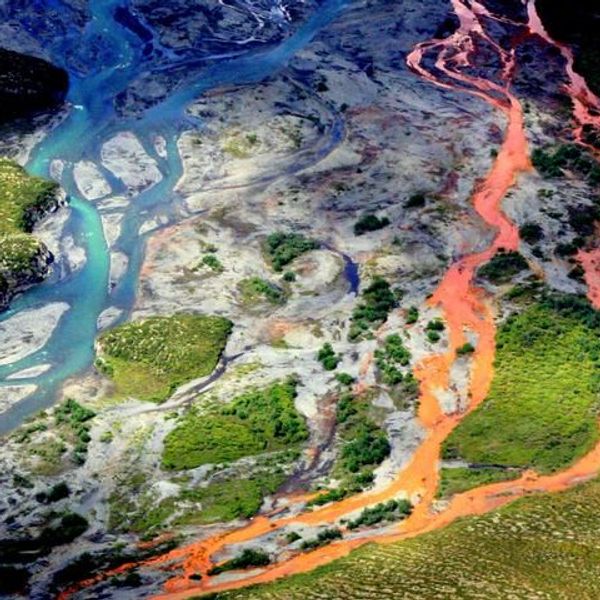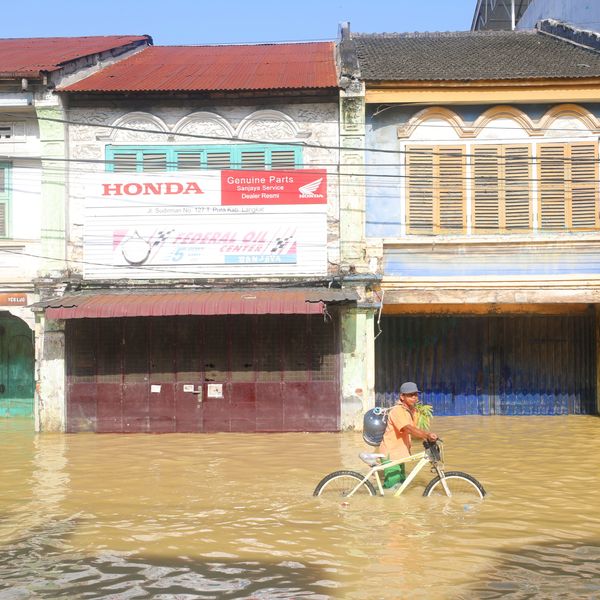Ten Weather Extremes That Defined Hottest Year Ever Recorded
From droughts to floods to mega-storms, extreme weather over the past 365 days raises disturbing questions about future of climate chaos
The hottest year in recorded history is coming to a close with a wave of extreme weather and ecosystem shifts, from unprecedented flooding in the United Kingdom to dangerous deluges in South America.
Looking back at 2015, it is clear that such extremes are not the exception but have been the rule for the past 365 days and beyond. Such weather is linked to this year's exceptionally strong El Nino and human-made global warming.
Communities on the frontlines of climate change have long warned that resultant floods, droughts, and mega-storms are already bringing death, displacement, and food insecurity to people across the globe, particularly those who are poor, Indigenous, or living in the global south.
Here are ten freakish weather extremes in 2015 that raised the alarm about climate chaos in 2016 and beyond and underscored the urgency of strong and effective adaptation, mitigation, and emissions reduction policies.
1. An Arctic heat wave at the end of December caused temperatures at the North Pole to spike 60 degrees Fahrenheit above the norm for the season, soaring past the freezing point and making the region hotter than cities across the United States and Europe.
2. In late December, this winter's El Nino caused severe floods across South America, including in Paraguay, Uruguay, Brazil, and Argentina. The floods displaced over 150,000 people.
3. Heavy rains this week caused the Mississippi River and its tributaries to overflow, touching off historic flooding in the U.S. Midwest. Climate scientists say that one of the most remarkable things about the deluge is the timing. "Never before has water this high been observed in winter along the river's levee system," meteorologist Jeff Masters explained.
4. South Africa is experiencing its worst drought in a generation, with soaring temperatures and paltry rainfalls believed to be worsened by El Nino. While the long-term impacts are not immediately known, according to UN estimates, at least 29 million people in southern African nations face food insecurity.
5. Due to a prolonged and ongoing drought in Ethiopia, more than 10 million people are in need of emergency food aid.
6. In November, over 1.1 million people were impacted--and 40,000 displaced--after a powerful and rare cyclone dumped a year's worth of rain on Yemen. Humanitarian groups warned that the impact on residents was worsened by Saudi Arabia's seven-month bombing campaign that continued through the storm.
7. In October, a mega-typhoon known as Lando hit the Philippines, affecting over 1.2 million people and killing dozens. In November, 20,000 people declared at a mass march in Tacloban that "our survival is non-negotiable," calling attention to the ongoing harm from the separate Super Typhoon Yolanda (also known as Haiyan), which hit the Philippines in 2013.

8. This summer, A dramatic heat wave across the Middle East caused temperatures in Iran to soar so high it felt like 160 degrees Fahrenheit. Even accounting for regional standards, temperatures spiked from Egypt to Syria. Thousands took to the streets across Iraq, protesting dangerous power cuts, clean water shortages, and poor living conditions that were worsening the effects.
9. Pakistan this summer suffered its deadliest heat wave ever recorded, with at least 2,000 lives lost. And in neighboring India, a heat wave this summer killed at least 2,500 people. "Let us not fool ourselves that there is no connection between the unusual number of deaths from the ongoing heat wave and the certainty of another failed monsoon," India's earth sciences minister, Harsh Vardhan, said in June. "It's not just an unusually hot summer, it is climate change," he said.
10. The National Oceanic and Atmospheric Administration concluded earlier this month that climate change is already driving profound shifts in the Arctic ecosystem. For example, the agency reported that the loss of sea ice and climbing temperatures in the Barents Sea, off the coast of Norway and Russia, are causing "a poleward shift in fish communities. " These changes are impacting wildlife and Indigenous communities that rely on them for their survival.
But perhaps most alarming are developments that cannot be seen. NOAA revealed in May that, for the first time in recorded history, global carbon dioxide levels in the atmosphere averaged over 400 parts per million (ppm) for an entire month--in March 2015. Scientists have warned that CO2 must be brought down to a maximum of 350 ppm to achieve safe levels.
As Erika Spanger-Siegfried of the Union of Concerned Scientists recently noted, climate change is causing all of these extremes.
"The specifics of what's happening where El Nino, Arctic dynamics, and underlying warming meet are, in a word, complex, and scientists are actively discussing how things might play out," explained Spanger-Siegfried. "But the collective bottom line recognizes that global warming plays a role."
Meanwhile, in a statement released this week, the humanitarian organization Oxfam International estimated that "the El Nino weather system could leave tens of millions of people facing hunger, water shortages, and disease next year if early action isn't taken to prepare vulnerable people from its effects."
An Urgent Message From Our Co-Founder
Dear Common Dreams reader, The U.S. is on a fast track to authoritarianism like nothing I've ever seen. Meanwhile, corporate news outlets are utterly capitulating to Trump, twisting their coverage to avoid drawing his ire while lining up to stuff cash in his pockets. That's why I believe that Common Dreams is doing the best and most consequential reporting that we've ever done. Our small but mighty team is a progressive reporting powerhouse, covering the news every day that the corporate media never will. Our mission has always been simple: To inform. To inspire. And to ignite change for the common good. Now here's the key piece that I want all our readers to understand: None of this would be possible without your financial support. That's not just some fundraising cliche. It's the absolute and literal truth. We don't accept corporate advertising and never will. We don't have a paywall because we don't think people should be blocked from critical news based on their ability to pay. Everything we do is funded by the donations of readers like you. Will you donate now to help power the nonprofit, independent reporting of Common Dreams? Thank you for being a vital member of our community. Together, we can keep independent journalism alive when it’s needed most. - Craig Brown, Co-founder |
The hottest year in recorded history is coming to a close with a wave of extreme weather and ecosystem shifts, from unprecedented flooding in the United Kingdom to dangerous deluges in South America.
Looking back at 2015, it is clear that such extremes are not the exception but have been the rule for the past 365 days and beyond. Such weather is linked to this year's exceptionally strong El Nino and human-made global warming.
Communities on the frontlines of climate change have long warned that resultant floods, droughts, and mega-storms are already bringing death, displacement, and food insecurity to people across the globe, particularly those who are poor, Indigenous, or living in the global south.
Here are ten freakish weather extremes in 2015 that raised the alarm about climate chaos in 2016 and beyond and underscored the urgency of strong and effective adaptation, mitigation, and emissions reduction policies.
1. An Arctic heat wave at the end of December caused temperatures at the North Pole to spike 60 degrees Fahrenheit above the norm for the season, soaring past the freezing point and making the region hotter than cities across the United States and Europe.
2. In late December, this winter's El Nino caused severe floods across South America, including in Paraguay, Uruguay, Brazil, and Argentina. The floods displaced over 150,000 people.
3. Heavy rains this week caused the Mississippi River and its tributaries to overflow, touching off historic flooding in the U.S. Midwest. Climate scientists say that one of the most remarkable things about the deluge is the timing. "Never before has water this high been observed in winter along the river's levee system," meteorologist Jeff Masters explained.
4. South Africa is experiencing its worst drought in a generation, with soaring temperatures and paltry rainfalls believed to be worsened by El Nino. While the long-term impacts are not immediately known, according to UN estimates, at least 29 million people in southern African nations face food insecurity.
5. Due to a prolonged and ongoing drought in Ethiopia, more than 10 million people are in need of emergency food aid.
6. In November, over 1.1 million people were impacted--and 40,000 displaced--after a powerful and rare cyclone dumped a year's worth of rain on Yemen. Humanitarian groups warned that the impact on residents was worsened by Saudi Arabia's seven-month bombing campaign that continued through the storm.
7. In October, a mega-typhoon known as Lando hit the Philippines, affecting over 1.2 million people and killing dozens. In November, 20,000 people declared at a mass march in Tacloban that "our survival is non-negotiable," calling attention to the ongoing harm from the separate Super Typhoon Yolanda (also known as Haiyan), which hit the Philippines in 2013.

8. This summer, A dramatic heat wave across the Middle East caused temperatures in Iran to soar so high it felt like 160 degrees Fahrenheit. Even accounting for regional standards, temperatures spiked from Egypt to Syria. Thousands took to the streets across Iraq, protesting dangerous power cuts, clean water shortages, and poor living conditions that were worsening the effects.
9. Pakistan this summer suffered its deadliest heat wave ever recorded, with at least 2,000 lives lost. And in neighboring India, a heat wave this summer killed at least 2,500 people. "Let us not fool ourselves that there is no connection between the unusual number of deaths from the ongoing heat wave and the certainty of another failed monsoon," India's earth sciences minister, Harsh Vardhan, said in June. "It's not just an unusually hot summer, it is climate change," he said.
10. The National Oceanic and Atmospheric Administration concluded earlier this month that climate change is already driving profound shifts in the Arctic ecosystem. For example, the agency reported that the loss of sea ice and climbing temperatures in the Barents Sea, off the coast of Norway and Russia, are causing "a poleward shift in fish communities. " These changes are impacting wildlife and Indigenous communities that rely on them for their survival.
But perhaps most alarming are developments that cannot be seen. NOAA revealed in May that, for the first time in recorded history, global carbon dioxide levels in the atmosphere averaged over 400 parts per million (ppm) for an entire month--in March 2015. Scientists have warned that CO2 must be brought down to a maximum of 350 ppm to achieve safe levels.
As Erika Spanger-Siegfried of the Union of Concerned Scientists recently noted, climate change is causing all of these extremes.
"The specifics of what's happening where El Nino, Arctic dynamics, and underlying warming meet are, in a word, complex, and scientists are actively discussing how things might play out," explained Spanger-Siegfried. "But the collective bottom line recognizes that global warming plays a role."
Meanwhile, in a statement released this week, the humanitarian organization Oxfam International estimated that "the El Nino weather system could leave tens of millions of people facing hunger, water shortages, and disease next year if early action isn't taken to prepare vulnerable people from its effects."
The hottest year in recorded history is coming to a close with a wave of extreme weather and ecosystem shifts, from unprecedented flooding in the United Kingdom to dangerous deluges in South America.
Looking back at 2015, it is clear that such extremes are not the exception but have been the rule for the past 365 days and beyond. Such weather is linked to this year's exceptionally strong El Nino and human-made global warming.
Communities on the frontlines of climate change have long warned that resultant floods, droughts, and mega-storms are already bringing death, displacement, and food insecurity to people across the globe, particularly those who are poor, Indigenous, or living in the global south.
Here are ten freakish weather extremes in 2015 that raised the alarm about climate chaos in 2016 and beyond and underscored the urgency of strong and effective adaptation, mitigation, and emissions reduction policies.
1. An Arctic heat wave at the end of December caused temperatures at the North Pole to spike 60 degrees Fahrenheit above the norm for the season, soaring past the freezing point and making the region hotter than cities across the United States and Europe.
2. In late December, this winter's El Nino caused severe floods across South America, including in Paraguay, Uruguay, Brazil, and Argentina. The floods displaced over 150,000 people.
3. Heavy rains this week caused the Mississippi River and its tributaries to overflow, touching off historic flooding in the U.S. Midwest. Climate scientists say that one of the most remarkable things about the deluge is the timing. "Never before has water this high been observed in winter along the river's levee system," meteorologist Jeff Masters explained.
4. South Africa is experiencing its worst drought in a generation, with soaring temperatures and paltry rainfalls believed to be worsened by El Nino. While the long-term impacts are not immediately known, according to UN estimates, at least 29 million people in southern African nations face food insecurity.
5. Due to a prolonged and ongoing drought in Ethiopia, more than 10 million people are in need of emergency food aid.
6. In November, over 1.1 million people were impacted--and 40,000 displaced--after a powerful and rare cyclone dumped a year's worth of rain on Yemen. Humanitarian groups warned that the impact on residents was worsened by Saudi Arabia's seven-month bombing campaign that continued through the storm.
7. In October, a mega-typhoon known as Lando hit the Philippines, affecting over 1.2 million people and killing dozens. In November, 20,000 people declared at a mass march in Tacloban that "our survival is non-negotiable," calling attention to the ongoing harm from the separate Super Typhoon Yolanda (also known as Haiyan), which hit the Philippines in 2013.

8. This summer, A dramatic heat wave across the Middle East caused temperatures in Iran to soar so high it felt like 160 degrees Fahrenheit. Even accounting for regional standards, temperatures spiked from Egypt to Syria. Thousands took to the streets across Iraq, protesting dangerous power cuts, clean water shortages, and poor living conditions that were worsening the effects.
9. Pakistan this summer suffered its deadliest heat wave ever recorded, with at least 2,000 lives lost. And in neighboring India, a heat wave this summer killed at least 2,500 people. "Let us not fool ourselves that there is no connection between the unusual number of deaths from the ongoing heat wave and the certainty of another failed monsoon," India's earth sciences minister, Harsh Vardhan, said in June. "It's not just an unusually hot summer, it is climate change," he said.
10. The National Oceanic and Atmospheric Administration concluded earlier this month that climate change is already driving profound shifts in the Arctic ecosystem. For example, the agency reported that the loss of sea ice and climbing temperatures in the Barents Sea, off the coast of Norway and Russia, are causing "a poleward shift in fish communities. " These changes are impacting wildlife and Indigenous communities that rely on them for their survival.
But perhaps most alarming are developments that cannot be seen. NOAA revealed in May that, for the first time in recorded history, global carbon dioxide levels in the atmosphere averaged over 400 parts per million (ppm) for an entire month--in March 2015. Scientists have warned that CO2 must be brought down to a maximum of 350 ppm to achieve safe levels.
As Erika Spanger-Siegfried of the Union of Concerned Scientists recently noted, climate change is causing all of these extremes.
"The specifics of what's happening where El Nino, Arctic dynamics, and underlying warming meet are, in a word, complex, and scientists are actively discussing how things might play out," explained Spanger-Siegfried. "But the collective bottom line recognizes that global warming plays a role."
Meanwhile, in a statement released this week, the humanitarian organization Oxfam International estimated that "the El Nino weather system could leave tens of millions of people facing hunger, water shortages, and disease next year if early action isn't taken to prepare vulnerable people from its effects."

